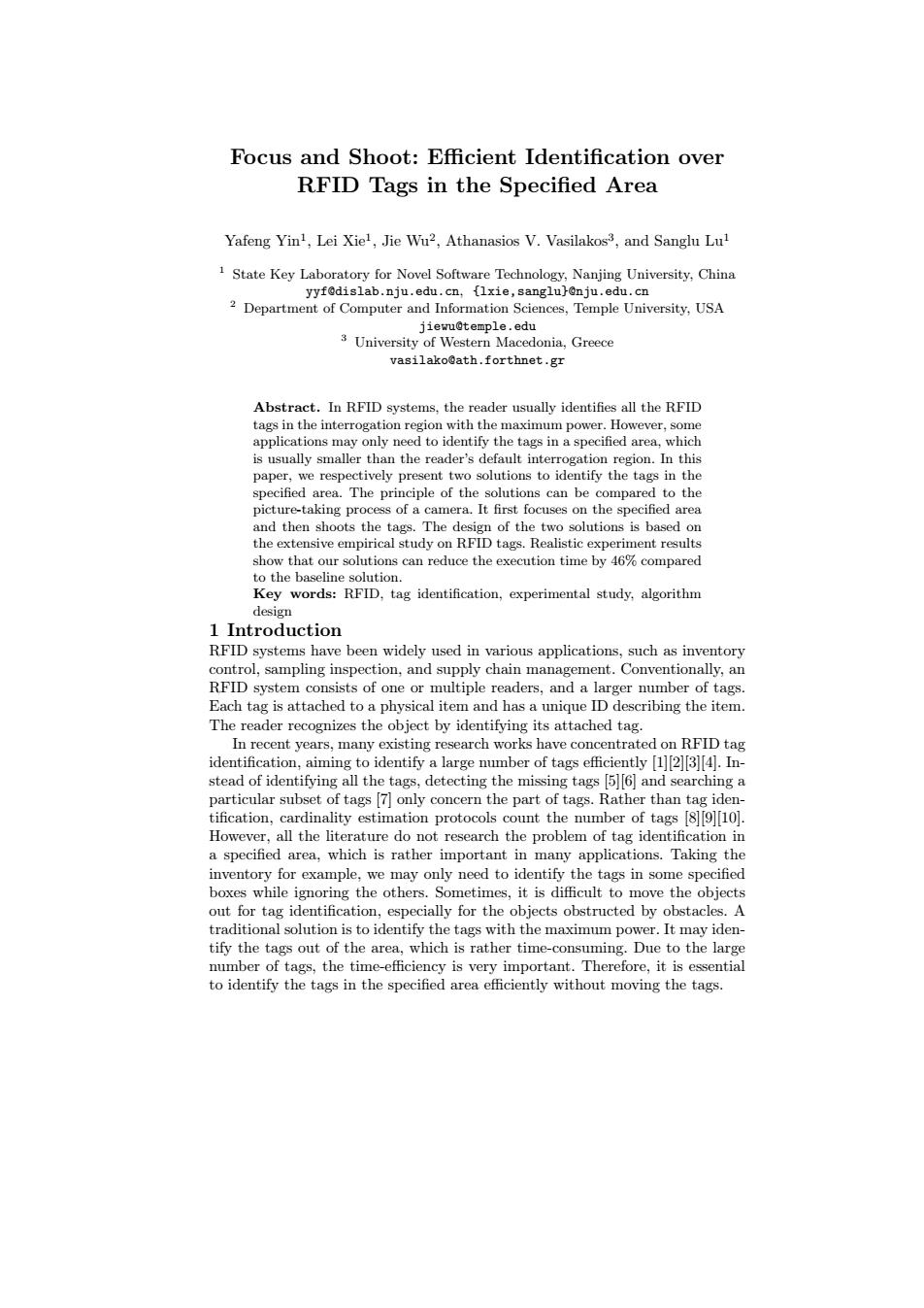正在加载图片...

Focus and Shoot:Efficient Identification over RFID Tags in the Specified Area Yafeng Yinl,Lei Xiel,Jie Wu2.Athanasios V.Vasilakos3,and Sanglu Lul 1 State Key Laboratory for Novel Software Technology,Nanjing University,China yyf@dislab.nju.edu.cn,{lxie,sanglu}@nju.edu.cn 2 Department of Computer and Information Sciences,Temple University,USA jiewu@temple.edu 3 University of Western Macedonia,Greece vasilako@ath.forthnet.gr Abstract.In RFID systems,the reader usually identifies all the RFID tags in the interrogation region with the maximum power.However,some applications may only need to identify the tags in a specified area,which is usually smaller than the reader's default interrogation region.In this paper,we respectively present two solutions to identify the tags in the specified area.The principle of the solutions can be compared to the picture-taking process of a camera.It first focuses on the specified area and then shoots the tags.The design of the two solutions is based on the extensive empirical study on RFID tags.Realistic experiment results show that our solutions can reduce the execution time by 46%compared to the baseline solution. Key words:RFID,tag identification,experimental study.algorithm design 1 Introduction RFID systems have been widely used in various applications,such as inventory control,sampling inspection,and supply chain management.Conventionally,an RFID system consists of one or multiple readers,and a larger number of tags. Each tag is attached to a physical item and has a unique ID describing the item. The reader recognizes the object by identifying its attached tag. In recent years,many existing research works have concentrated on RFID tag identification,aiming to identify a large number of tags efficiently [1][2][3][4].In- stead of identifying all the tags,detecting the missing tags [5][6]and searching a particular subset of tags [7]only concern the part of tags.Rather than tag iden- tification,cardinality estimation protocols count the number of tags 8910 However,all the literature do not research the problem of tag identification in a specified area,which is rather important in many applications.Taking the inventory for example,we may only need to identify the tags in some specified boxes while ignoring the others.Sometimes,it is difficult to move the objects out for tag identification,especially for the objects obstructed by obstacles.A traditional solution is to identify the tags with the maximum power.It may iden- tify the tags out of the area,which is rather time-consuming.Due to the large number of tags,the time-efficiency is very important.Therefore,it is essential to identify the tags in the specified area efficiently without moving the tags.Focus and Shoot: Efficient Identification over RFID Tags in the Specified Area Yafeng Yin1 , Lei Xie1 , Jie Wu2 , Athanasios V. Vasilakos3 , and Sanglu Lu1 1 State Key Laboratory for Novel Software Technology, Nanjing University, China yyf@dislab.nju.edu.cn, {lxie,sanglu}@nju.edu.cn 2 Department of Computer and Information Sciences, Temple University, USA jiewu@temple.edu 3 University of Western Macedonia, Greece vasilako@ath.forthnet.gr Abstract. In RFID systems, the reader usually identifies all the RFID tags in the interrogation region with the maximum power. However, some applications may only need to identify the tags in a specified area, which is usually smaller than the reader’s default interrogation region. In this paper, we respectively present two solutions to identify the tags in the specified area. The principle of the solutions can be compared to the picture-taking process of a camera. It first focuses on the specified area and then shoots the tags. The design of the two solutions is based on the extensive empirical study on RFID tags. Realistic experiment results show that our solutions can reduce the execution time by 46% compared to the baseline solution. Key words: RFID, tag identification, experimental study, algorithm design 1 Introduction RFID systems have been widely used in various applications, such as inventory control, sampling inspection, and supply chain management. Conventionally, an RFID system consists of one or multiple readers, and a larger number of tags. Each tag is attached to a physical item and has a unique ID describing the item. The reader recognizes the object by identifying its attached tag. In recent years, many existing research works have concentrated on RFID tag identification, aiming to identify a large number of tags efficiently [1][2][3][4]. Instead of identifying all the tags, detecting the missing tags [5][6] and searching a particular subset of tags [7] only concern the part of tags. Rather than tag identification, cardinality estimation protocols count the number of tags [8][9][10]. However, all the literature do not research the problem of tag identification in a specified area, which is rather important in many applications. Taking the inventory for example, we may only need to identify the tags in some specified boxes while ignoring the others. Sometimes, it is difficult to move the objects out for tag identification, especially for the objects obstructed by obstacles. A traditional solution is to identify the tags with the maximum power. It may identify the tags out of the area, which is rather time-consuming. Due to the large number of tags, the time-efficiency is very important. Therefore, it is essential to identify the tags in the specified area efficiently without moving the tags